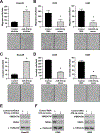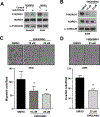Targeting of SGK1 by miR-576-3p Inhibits Lung Adenocarcinoma Migration and Invasion
- PMID: 30257988
- PMCID: PMC6318035
- DOI: 10.1158/1541-7786.MCR-18-0364
Targeting of SGK1 by miR-576-3p Inhibits Lung Adenocarcinoma Migration and Invasion
Abstract
Metastatic lung cancer is common in patients with lung adenocarcinoma, but the molecular mechanisms of metastasis remain incompletely resolved. miRNA regulate gene expression and contribute to cancer development and progression. This report identifies miR-576-3p and its mechanism of action in lung cancer progression. miR-576-3p was determined to be significantly decreased in clinical specimens of late-stage lung adenocarcinoma. Overexpression of miR-576-3p in lung adenocarcinoma cells decreased mesenchymal marker expression and inhibited migration and invasion. Inhibition of miR-576-3p in nonmalignant lung epithelial cells increased migration and invasion as well as mesenchymal markers. Serum/glucocorticoid-regulated kinase 1 (SGK1) was a direct target of miR-576-3p, and modulation of miR-576-3p levels led to alterations in SGK1 protein and mRNA as well as changes in activation of its downstream target linked to metastasis, N-myc downstream regulated 1 (NDRG1). Loss of the ability of miR-576-3p to bind the 3'-UTR of SGK1 rescued the inhibition in migration and invasion observed with miR-576-3p overexpression. In addition, increased SGK1 levels were detected in lung adenocarcinoma patient samples expressing mesenchymal markers, and pharmacologic inhibition of SGK1 resulted in a similar inhibition of migration and invasion of lung adenocarcinoma cells as observed with miR-576-3p overexpression. Together, these results reveal miR-576-3p downregulation is selected for in late-stage lung adenocarcinoma due to its ability to inhibit migration and invasion by targeting SGK1. Furthermore, these results also support targeting SGK1 as a potential therapeutic for lung adenocarcinoma. IMPLICATIONS: This study reveals SGK1 inhibition with miR-576-3p or pharmacologically inhibits migration and invasion of lung adenocarcinoma, providing mechanistic insights into late-stage lung adenocarcinoma and a potential new treatment avenue.
©2018 American Association for Cancer Research.
Conflict of interest statement
Conflict of interest: The authors declare no conflicts of interest.
Figures






Similar articles
-
[miR-144-3p Inhibits the Invasion and Metastasis of Lung Adenocarcinoma Cells by Targeting IRS1].Zhongguo Fei Ai Za Zhi. 2021 May 20;24(5):323-330. doi: 10.3779/j.issn.1009-3419.2021.104.05. Zhongguo Fei Ai Za Zhi. 2021. PMID: 34034455 Free PMC article. Chinese.
-
LncRNA TTN-AS1 drives invasion and migration of lung adenocarcinoma cells via modulation of miR-4677-3p/ZEB1 axis.J Cell Biochem. 2019 Oct;120(10):17131-17141. doi: 10.1002/jcb.28973. Epub 2019 Jun 7. J Cell Biochem. 2019. PMID: 31173403
-
Novel long non-coding RNA LINC02323 promotes epithelial-mesenchymal transition and metastasis via sponging miR-1343-3p in lung adenocarcinoma.Thorac Cancer. 2020 Sep;11(9):2506-2516. doi: 10.1111/1759-7714.13562. Epub 2020 Jul 9. Thorac Cancer. 2020. PMID: 32643848 Free PMC article.
-
Serum and glucocorticoid-regulated kinase 1 (SGK1) as an emerging therapeutic target for cardiac diseases.Pharmacol Res. 2024 Oct;208:107369. doi: 10.1016/j.phrs.2024.107369. Epub 2024 Aug 28. Pharmacol Res. 2024. PMID: 39209082 Review.
-
SGK1, autophagy and cancer: an overview.Mol Biol Rep. 2022 Jan;49(1):675-685. doi: 10.1007/s11033-021-06836-6. Epub 2021 Oct 20. Mol Biol Rep. 2022. PMID: 34669124 Review.
Cited by
-
MicroRNA‑mediated regulation in lung adenocarcinoma: Signaling pathways and potential therapeutic implications (Review).Oncol Rep. 2023 Dec;50(6):211. doi: 10.3892/or.2023.8648. Epub 2023 Oct 20. Oncol Rep. 2023. PMID: 37859595 Free PMC article. Review.
-
miR‑576‑3p/M‑phase phosphoprotein 8 axis regulates the malignant progression of hepatocellular carcinoma cells via the PI3K/Akt signaling pathway.Oncol Lett. 2024 May 16;28(1):327. doi: 10.3892/ol.2024.14460. eCollection 2024 Jul. Oncol Lett. 2024. PMID: 38807669 Free PMC article.
-
MiRNAs in Lung Adenocarcinoma: Role, Diagnosis, Prognosis, and Therapy.Int J Mol Sci. 2023 Aug 27;24(17):13302. doi: 10.3390/ijms241713302. Int J Mol Sci. 2023. PMID: 37686110 Free PMC article. Review.
-
Identification of Acute Myeloid Leukemia Bone Marrow Circulating MicroRNAs.Int J Mol Sci. 2020 Sep 25;21(19):7065. doi: 10.3390/ijms21197065. Int J Mol Sci. 2020. PMID: 32992819 Free PMC article.
-
HDAC2 interacts with microRNA-503-5p to regulate SGK1 in osteoarthritis.Arthritis Res Ther. 2021 Mar 9;23(1):78. doi: 10.1186/s13075-020-02373-y. Arthritis Res Ther. 2021. PMID: 33750441 Free PMC article.
References
-
- Siegel RL, Miller KD, and Jemal A, Cancer statistics, 2018. CA Cancer J Clin 2018;68:7–30. - PubMed
Publication types
MeSH terms
Substances
Grants and funding
LinkOut - more resources
Full Text Sources
Other Literature Sources
Medical

